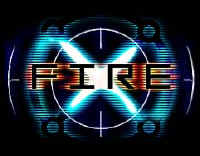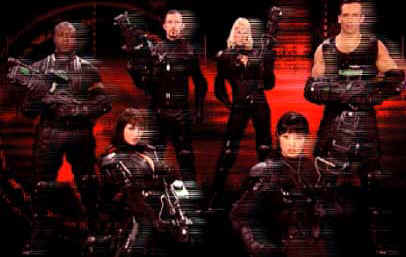X-Fire

Contents |
Host
Broadcast
TV21 for Channel 4, 25 September 2001 to 10 July 2002 (12 episodes in 1 series + 1 unaired)
Synopsis
If you cross two electrical cables together chances are it will short circuit. Fight fire with fire and you get a big fire and you might get burnt. Luckily X-Fire (pronounced Cross-Fire) doesn't involve electricity or fire - just lots of paint and a title that's not as clever as it thinks it is.
This is a show that's a veritable Innovations catalogue of innovation. Look at the innovative use of the X to represent the word 'cross' in the title. Look at those innovative pseudo-wireframe computer graphics. Look at the subject matter: other than an obscure show on Sky, paintballing hasn't been done properly on TV before. Look also at the innovative use of bad acting and fake cleavage. We'll come back to all of these in a minute.
The best way to describe it would be a mixture of X-Files, Goldeneye, Half-Life and Changing Rooms. A team of six players meet up with host Ed Hall in an abandoned airfield somewhere and are given missions in order to strike a blow against the Special Forces, six paintballing experts who have all been given silly call signs. These missions range from stopping terrorist attacks to stealing evidence of alien life that has crash landed to foiling a plan to counterfeit money. Each episode has three timed missions which build up in scope and difficulty each relating to the main 'theme' of that week's episode.
In each mission the team tries to earn credits, mostly by shooting "grunts" (i.e. your casual worker types) or by taking out members of the Special Forces (trained paint-ballers, worth lots and lots of credits). Credits are given in large numbers for completing the mission, and bonus credits are given for each member surviving plus 'teamwork' and 'bravery'. Credits are taken away for cheating (boo!) and being 'wounded' - that is, taking a shot on the arms or legs. Any other shots cause death or, as they call it, "emulsification" - a word we've only previously seen used during the manufacture of meringue.
Each team member begins with a gun and some ammo plus whatever they can afford credits-wise before the next mission (shields, smoke bombs etc). The game begins with the X-Fire van speeding into play and braking suddenly (a nice touch), whereby the back doors unlock and the team can pile out of the van and start the mission. The team are dressed in orange but their torsos are covered in black. If they take a hit to their helmets or torso then they have been emulsified and must play dead (i.e. lie down dramatically, eyes closed). All the baddies are clothed in black so it's not difficult to distinguish between good and bad guys. Between missions the remaining players (or the captain if everyone died) can choose to reincarnate anybody currently emulsified for the wallet busting fee of 200 credits.
In the third and final mission they can play for half, normal or double credits depending on what difficulty they choose (Easy, Standard or Extreme) containing four, five or all six Special Forces. At the end of the series the team with the most credits gets has earned the chance to go again and this time save the world. Which sounds quite exciting, doesn't it?
Production-wise this seems to have put a lot of thought put into it. The editorial balance of treating it as a computer game but one where the outcome matters has been handled sensibly, so while the players get shot we see they're OK after the mission so that's alright then. While the graphics in most TV shows try to look like they've come from a film, these graphics really do appear to be film quality. Graphics pop-up everywhere: before each mission there's a 3D fly-through of the level; when people get shot a little icon pops up to represent this. All the writing is in a techno-futuresque font and the clock counts down in hundredths of a second(!) - but is it us or is the clock rrrrrigged? Anyway, it's all very lovely, and there's even the director's trademark emotionless computery voice.
All the contestants and Special Forces are introduced in the style of Gladiators and in quite a nice touch the Forces are ranked depending on how many people they've shot throughout the series. Irritatingly, the clock appears and then seems to disappear for quite a long length of time. For better or worse, this seems to make the missions feel a lot longer than they perhaps should.
 The Special Forces
The Special ForcesEd Hall is a good host for this, deadpanning his way through the commentary in that cockney staccato delivery that he is wont to do and holds the show together quite well. If there's one point where the links don't work, it's the piece-to-camera one-liner before the mission starts.
The six Special Forces enjoy their roles and there's quite a nice variation of them - the nerd, the Russian gymnast, the brick outhouse, the vamp, the Russian gymnast, the body builder, the ninja queen... and there's the Russian gymnast as well. Amusingly but oddly, Mr Hall will often mock the witticisms they come out with (e.g. A.J. says "Winners don't quit, quitters don't win," only for Ed to add in the commentary "Wise words from A.J. there. Let's hope he doesn't have any more.").
The other thing is that no matter how you do it up, paintball is still paintball. It's probably very exciting to play but if it wasn't for the OTT presentation we'd get very bored very quickly. This is mainly due to the fact that all the missions seem very similar, just shot in different places (read: airport out-buildings). All the missions seem to be along the lines of:
PRIMARY OBJECTIVE: Find A. Use it to get B. Use B to destroy C. Get out. In a warehouse.
SECONDARY OBJECTIVE: You've got to shoot as many grunts as you can. And other bad guys.
TERTIARY OBJECTIVE: Don't get shot.
The puzzles are rudimentary to the point of being pointless. The teams are given far too much information about each mission before they start. It would be more fun to watch if they had a fair bit of stuff to work out for themselves whilst shooting people rather than giving them everything on a plate in the 'dossier'. James Bond didn't get maps in Goldeneye and yet that still works well doesn't it?
The other quibble is that the whole thing is just a bit "too much". The music's just a bit too loud, the graphics fly past just too quickly, the pre-mission run-throughs are just too confusing to be worthwhile. While this information overload is fine for kiddies, it seems that no-one cares whether the adults follow it or not. And it's on at 6pm? What a joke. Channel 4 used to put this sort of thing on at primetime. Still, there's always Temptation Island for the adults, eh?
It's these things that stop the show from being 'must watch' - instead, it's a good hour's worth of entertainment if you're in the mood for it. Otherwise, it's a little frustrating in places. Like our old friend the Innovations catalogue, it looks lovely and is fun to read - but nobody actually orders anything from them, do they?
Inventor
James Bagshawe
Theme music
Kick Productions
Trivia
The series was taken off the air after five weeks in autumn 2001, as it was felt to be a little too close to the real-life battle in Afghanistan. The remaining episodes went out in summer 2002 - that's apart from one called "Star Wars", which has never been broadcast.
The airbase location where X-Fire was filmed was later used for Channel 4's grand hoax, Space Cadets, and for The Almost Impossible Gameshow.

